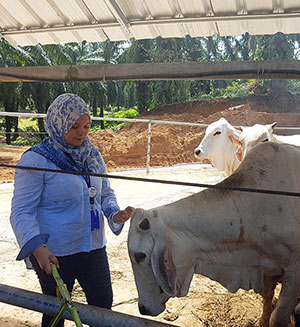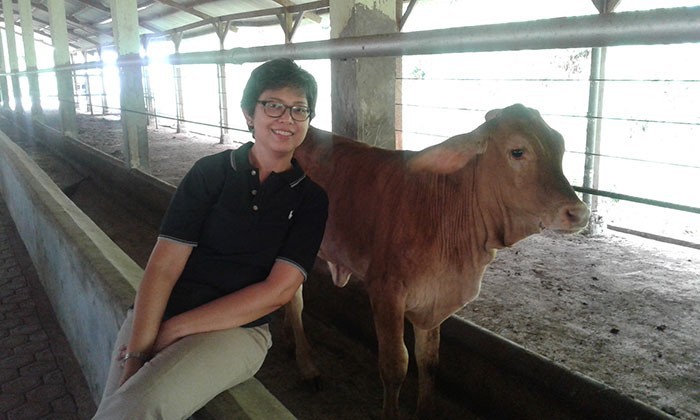Women in the Cattle Shed
Read the story of Women in the Cattle Shed, a motivated and highly committed women who works tirelessly hoping to make significant and lasting change in their community.
“The cattle-palm integration model is new for us. That means there will be times when you unfortunately make mistakes. It is from this Partnership I understand that mistakes are an opportunity to learn. In just six months of this Partnership, we have learned a lot and we know that there are still many pages to open for study,” said Satia Pratiwi known as Ibu Teta, the Head of Business Development Division of Bio Nusantara Technology (BNT).
Palm-oil leaves, abundant on BNT plantations that cover an area of 6000 hectares, were previously left to fall to the ground to decompose naturally. However, this natural process takes a very long time and Ibu Teta and her team sharply observed the opportunity to utilize palm-oil leaves more productively. That is, that the cattle–palm integration system could utilize palm-oil leaves as one of the forage options for livestock feed.
“The palm-oil leaves can be utilized more effectively together with the CPO’s (crude palm oil) by-product (palm kernel cake) as cattle feed. These potential resources must be utilized to produce something positive,” said Ibu Teta.
BNT implemented a cattle project in 2013 with Bali cattle. Although the results were not as desired, BNT refused to give up and decided to explore if other models of cattle breeding and other breeds would be more effective. In 2015, BNT piloted the breed-lot model (described below) using 26 Australia imported Brahman Cross (BX) cattle. The results were technically promising. This convinced BNT to continue its cattle breeding project but more professionally. Then came the opportunity to partner with IACCB, which was greeted with enthusiasm. “We chose this Partnership because it is in line with our company's strategic business direction,” says Teta.
As a result of the partnership between BNT and IACCB, the number of cattle that are being managed has increased greatly and with a new feeding system. This is rotational grazing using electric fencing which was very new to Bu Teta and her team. Additionally, the BNT project is trialling a combination of the ‘breed-lot’ model (where cattle are bred in pens) and grazing under palms. This differs from the other IACCB SISKA projects. IACCB delivered 246 Australian imported heifers and 13 bulls to BNT which, when coupled with the already existing herd in the BNT, multiplied the size of the herd.
At the beginning of the cattle breeding pilot project, Ibu Teta's position required her to manage all matters related to the program. At that time, the number of cattle was relatively small and manageable hence a cattle management team was not yet appointed.
Nowadays, the cattle-palm integration has a lot more cattle and it is not as easy a task to manage. She is grateful to have support from the company leader, whom she says has a strong vision and commitment to prove that the integration model will work. The company provides a veterinarian and a livestock expert to support the program. Despite occupying a top management position in the company Teta, who graduated in Industrial Engineering and has a depth of work experiences, admits learning is continuous.
The veterinarian who serves in BNT, Yulissa Fitrianis, also indicated that she is very happy to have the opportunity to learn about management by working directly with Ibu Teta as the Deputy Head of Development. Her background as a veterinarian does not necessarily make her a livestock expert and each day presents new learnings about cattle feeding, nutrition and cattle diseases.
Ibu Teta recruited Yulissa because she saw her potential, and believes that all potential in women and men should be respected. Currently, the female workforce in the cattle sector are mainly labourers, such as palm frond collectors. Rarely do women gain positions at a management level. However, she emphasized that BNT always opens its doors for women: “in accordance with the BNT spirit, we never set limits for women to work in this sector so far if they are capable to manage the position."
Having a leadership position in management, Teta is able to set an example for other women to work in an area predominantly occupied by men, and has encouraged other women to take the job opportunities and make a difference. This is supported by Yulissa, who said that she is pleased to have the company’s full support. When she has to travel to the palm-oil plantation in the middle of the night for a cattle emergency case, the company facilitates her work and ensures her safety. Such safe and supportive working conditions are crucial for promoting equal treatment and respect for men and women at work.

Yulissa is examining the project cattle
The bigger challenge they face is with actual herd management, because there are many things that are not as easy as the concept on paper. BNT itself is relatively new in implementing the SISKA model, so it lacks knowledge about many aspects, including cattle nutrition and grazing. As a result, there are some cases where cattle Body Condition Scores (BCS) declined rapidly. This will affect herd conception rates.
"With strong technical support from IACCB, we are trying to improve such conditions," said Yulissa.
As a veterinarian learning about cattle breeding on the job, Yulisa claimed herself lucky to be able to call on her colleagues at IACCB.
“I never hesitate to consult with Cut Dara, a vet at the IACCB office who has a lot of knowledge about cattle.”
One thing she really wants from this experience is to build her capacity to handle cases such as prolapses, how to insert gastric hoses, and other emergencies.
"I personally view capacity building as not necessarily having to be in formal training or workshops. Exchanging information through individual approaches with the experts has helped me develop my capacity better. I am also grateful to be able to learn from Doctor Ross Ainsworth, Animal Husbandry Advisor with the IACCB Program."
One of the strategies applied by Ibu Teta, to ensure the success of SISKA breeding model, is to strengthen the capacity of her staff. What matters is not just the cattle business development, but also the human development.
"I want my staff to not be discouraged if a cow or bull dies. They must learn from mistakes and prevent it from happening again. For example, if an animal becomes sick and dies from ingesting plastic waste, we have to do something about cleaning up the waste. Ensuring the cleanliness of a very large palm-oil plantation is not an easy thing for us to handle, however I find it to be an exciting challenge.”
Teta has high expectations for this partnership: "As far as I understand from this Partnership, IACCB is looking to develop sustainable breeding models that can be replicated elsewhere.”
In line with the company's vision and mission, Yulissa also sincerely hopes that the SISKA model will succeed. “We expect that through the Partnership with IACCB, and its wider network in the farming and cattle sector, we can be guided to achieve the most suitable cattle breeding model in Indonesia.”
Ibu Teta and Yulissa are two capable women determined to make a difference. By embracing every opportunity to build their knowledge and contribute to the pilot’s success, they are forging a new path in a challenging sector in more ways than one.





